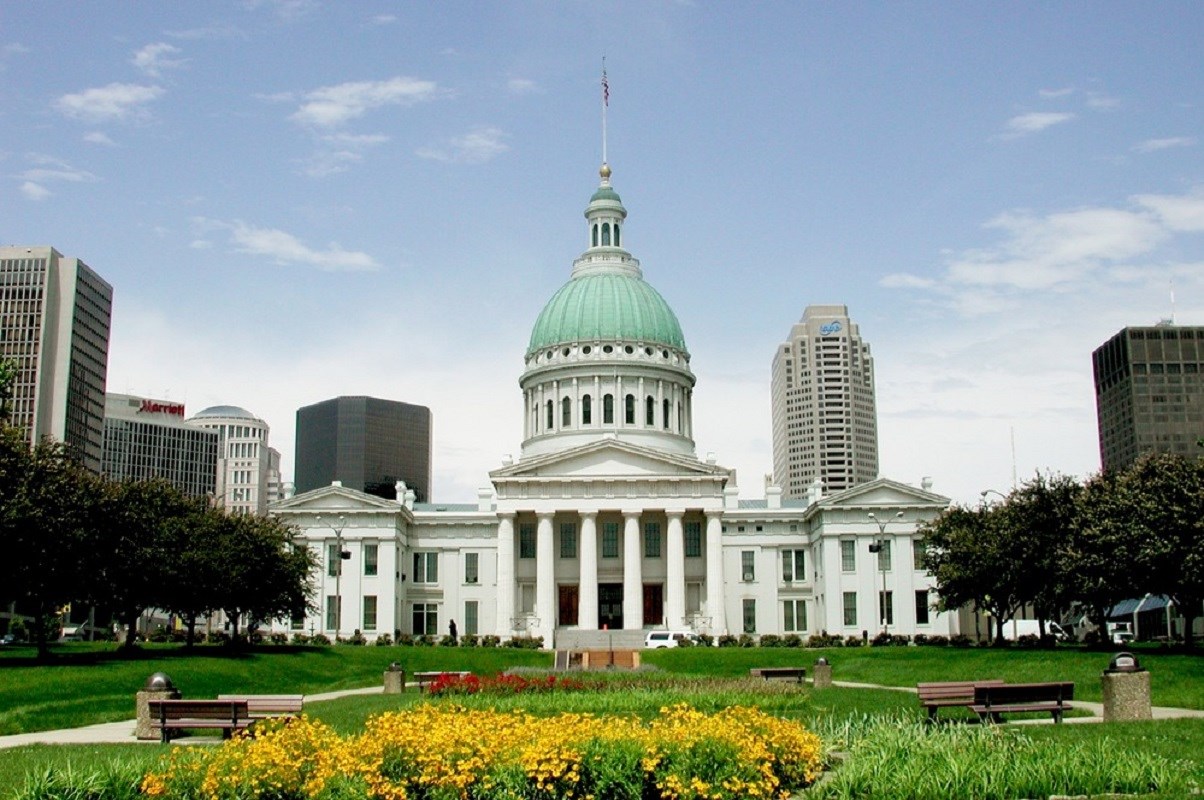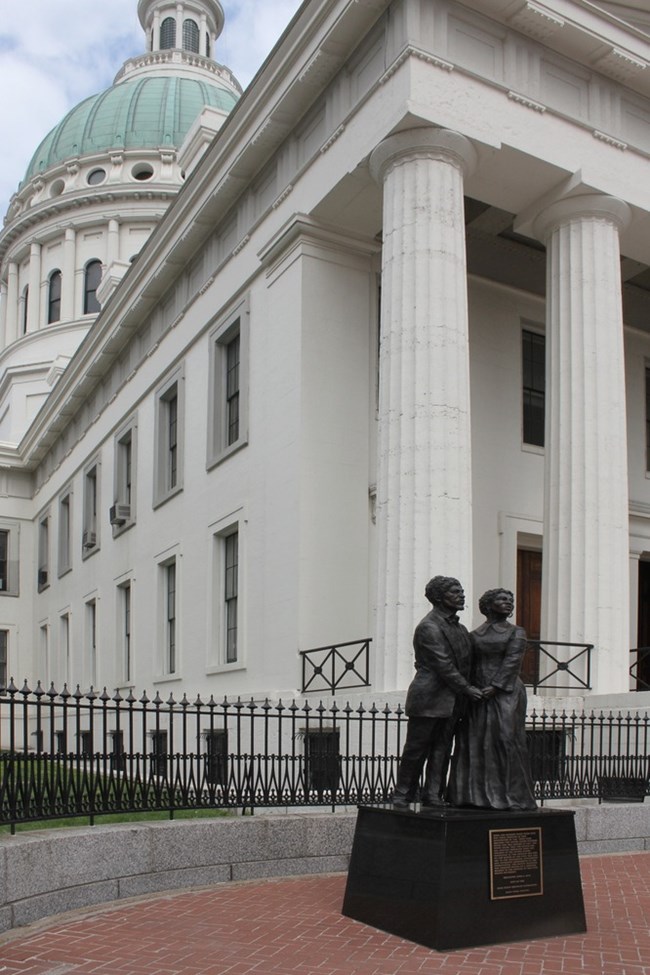Part of a series of articles titled Claiming Civil Rights .
Article
(H)our History Lesson: Suing for Freedom, Dred and Harriet Scott’s Case at the Old Courthouse
This lesson was adapted by Katie McCarthy from the full-length Teaching with Historic Places lesson plan “The Old Courthouse in St. Louis: Yesterday and Today.” For more information about this topic, explore the full lesson plan.
Grade Level Adapted For:
This lesson is intended for middle school learners but can easily be adapted for use by learners of all ages.
Lesson Objectives:
Students will be able to...
- Explain how a legal verdict such as the Dred Scott decision can affect national policy.
- Understand how the Dred Scott decision was influenced by national politics and rising tensions pre-Civil War.
- Cite specific textual evidence to support analysis of primary and secondary sources.
- Determine the central ideas or information of a primary or secondary source.
Inquiry Question:
Examine the photo below. Based on the way this building looks, what kinds of things happen here? Why might these things be important? Other than the way the building is designed, what kind of information would help you answer that question?

Reading:
Background:
The Old Courthouse in downtown St. Louis was the site of many events that affected the nation. In the 1840s and 1850s, the courthouse's rotunda was an arena for great speeches, debates, and discussions on the possibilities of building railroads across the continent. During this same period, one of the courtrooms was the setting for the portentous Dred Scott trial.
The courthouse as it exists today took nearly 40 years to complete. The original brick structure built in 1828 soon became too small for the growing city of St. Louis. A classical Greek Revival design that incorporated the brick courthouse as its east wing was opened on February 22, 1845. Throughout the years the courthouse continued to be remodeled and enlarged. The brick east wing was eventually replaced and another larger, more elaborate dome was designed and constructed. Finally, on July 4, 1862, the courthouse was declared officially complete. It was the tallest and most impressive building in St. Louis, rising more than 190 feet.

Content:
Perhaps the most famous court case associated with the Old Courthouse is that of two enslaved individuals, Dred and Harriet Scott. In 1846 the Scotts filed a suit to obtain their freedom from slavery. At the time, the case was not an unusual one and there was little coverage of the trial in the local newspapers. Slavery was legal in Missouri and enslaved people often sued for their freedom. Some argued that they had been freed by a previous owner’s will. Other enslaved people sued for their liberty because their owners had taken them to a non-slave-holding territory and then returned to Missouri. The courts commonly granted freedom in both circumstances until the Dred and Harriet Scott case.
Dred Scott was brought to St. Louis from Virginia in 1830 by his enslaver, Peter Blow. Later the Blow family sold Scott to Dr. John Emerson, an army surgeon. Scott accompanied his new owner on tours of duty at Rock Island, Illinois, and Fort Snelling in Wisconsin Territory (what is now Minnesota). At Fort Snelling, Scott married an enslaved woman named Harriet who Dr. Emerson had purchased. In 1843 Emerson died, leaving the Scotts to his widow. In April 1846 Dred and Harriet Scott filed suit against Mrs. Irene Emerson for their freedom. They based their case on previous residence in free territory.
The Illinois state constitution outlawed slavery. Slavery had been outlawed in Wisconsin Territory due to the Missouri Compromise. The Missouri Compromise banned slavery in territories north Missouri’s southern border, except for in Missouri itself. The court had to decide whether the Scotts could be considered free because Dr. Emerson had kept them enslaved while living in two “free soil” areas. Some believed that the Scotts were wrongly held as slaves in Illinois and Wisconsin Territory and should be free. Some believed that the Scotts were nothing more than property and had no right to declare their freedom.
The case came to trial in June 1847 in the Missouri Circuit Court, and was lost by the Scotts. They asked for a retrial. At a second hearing, in 1850, the Scotts won their freedom. These first two trials happened at the St. Louis Old Courthouse. Mrs. Emerson appealed the case to the Missouri State Supreme Court. In 1852 the Missouri State Supreme Court reversed the decision of the lower court. This returned the couple to slavery.
After the Missouri State Supreme Court decision, the Dred and Harriet Scott case began to attract national attention and the interest of prominent lawyers. By the 1850s, Americans were seriously debating how the spread or abolition of slavery would affect the growing country. Since the Scotts first filed their suit in 1846, tensions between the North and the South had grown. Laws regarding slavery had been passed at local, state, and national levels. These laws caused much dissension between the two regions of the country. Roswell Field, an accomplished attorney, took on the case and carried it to the Federal District Court. In May 1854, that court ruled in favor of Dred Scott's owner. Field immediately appealed to the U.S. Supreme Court. There was intense interest in the U.S. Supreme Court's decision regarding the Scotts. Whatever the Supreme Court decided would become national law.
The Supreme Court heard the case argued as Dred Scott v. Sandford because, technically, Scott was now the property of Emerson's brother-in-law, John F. A. Sanford (a clerk misspelled the name of the defendant). The Supreme Court held hearings twice: once in February 1856 and again the following December.
The decision was delivered on March 6, 1857 by Chief Justice Roger Taney, who read the "Opinion of the Court." Seven Justices agreed and two disagreed with the decision. The Supreme Court decided that because the Scotts were slaves, they were not considered citizens under the Constitution. Therefore, they could not sue for their freedom in court. This ruling legitimized the misguided belief that enslaved people were not fully humans.
The justices also ruled that the ban on slavery in the Missouri Compromise was unconstitutional. This meant that slave owners could not be deprived of their property, even if they moved to a state that outlawed slavery. Now, recently acquired western territories had to allow slave holders, and thus slavery, within their borders. The decision struck a blow to the delicate balance of states that allowed slavery and those that did not. Instead of lessening sectional tensions as Chief Justice Taney had hoped, the decision only hastened the nation’s slide into civil war.
Reading Discussion Questions:
-
What reason did Dred and Harriet Scott first sue for their freedom?
-
Write a list of the dates and places where the Scotts went to court. How many times was their case tried in total?
-
Which court case or cases happened in St. Louis?
-
Why did people become interested in their court case? What else was happening in the country at the time?
-
What did the Supreme Court decide about the case?
-
What role did this decision play in leading to the Civil War?
Activities:
In each of these activities, learners investigate national tensions at the time of the Scott case. In the first, participants map how the balance between “free” and “slave” states in the decades leading up to the case. In the second, learners imagine and draw how the Supreme Court looked during the trial.
Activity 1: Mapping the Balance of States
The growing tensions between states in which slavery was allowed and states in which it was outlawed was one of the reasons the Dred Scott case was so important to people at the time. Keeping these states in balance was considered crucial to keeping the country together. Neither side wanted the other to have the majority of power in Congress. In order to picture this balance, learners can fill out maps depicting which states or territories allowed slavery at key dates: 1789, 1821, 1846, 1858, and 1861. Maps may be filled out individually or in teams. Once the maps are completed, consider the following questions:
-
How many slave and free states are there on each map?
-
How does the amount of the country were slavery is legal or outlawed change over time?
-
What did the country look like at the time of the Dred Scott case?
-
How did this balance (or imbalance) play a role in the outcome of the case?
Activity 2: Be a Courtroom Sketch Artist
We don’t have any pictures of the court cases the Scotts participated in. Instead, we have to imagine what the courtroom felt like and looked like during the trials. In modern day courtrooms, sketch artists draw the scene for news articles. Now, it’s your turn to picture what the courtroom looked like! Choose one of the series of court cases the Scotts participated in, and draw what you think the courtroom looked like. In addition to your imagination, you can use pictures of the Old Courthouse from the National Park Service’s website, which you can find here. While you draw, consider the following points:
-
Who is in the courtroom?
-
Who are the judges hearing the case? Who are the lawyers? What are their backgrounds?
-
Are there people listening to the trial? What do they look like? What do they care about?
-
What kinds of emotions might people in the courtroom be feeling?
-
What point of the trial is your picture capturing?
Wrap-up:
-
Where do court cases take place in your community? When was this courthouse or building built?
-
Why do you think the Dred Scott case was so important at the time it was decided? Why is it important now?
-
How do you think the Scotts felt during the different court cases they participated in?
-
What would you like to know more about or explore? What is missing that you’re curious about still?
Additional Resources:
Library of Congress
The Library of Congress Dred Scott v. Sanford Web Guide provides a collection of primary documents, including newspaper articles about the decision, Abraham Lincoln’s and Frederick Douglass’ responses to the decision, and court records.
Gateway Arch National Park
The park provides an overview of the Dred Scott Case as well as information about the African American community in St. Louis at the time and slavery in Missouri.
Tags
- dred scott
- dred scott case
- st. louis
- missouri history
- missouri
- courthouse
- african american history
- national register of historic places
- teaching with historic places
- twhp
- hour history lessons
- educational activity
- civics
- civil rights
- african american
- african american civil rights
- shaping the political landscape
- immigration and migration
- mid 19th century
- slavery
- twhplp
- ea aah
- cwr aah
Last updated: May 11, 2023
